Abstract
Desertification is a critical environmental problem in China’s northwestern region. In this context, since the early 2000s, projects targeting ecological restoration have been implemented in the lower reaches of the Heihe River basin. Using multi-scale remote sensing data and field observations, this paper examines the outcomes of the ecological restoration projects. Specifically, this paper examines the vegetation change through remote sensing and local perceptions of the projects through semi-structured questionnaires. The results from remote sensing reveal that during the restoration projects, vegetation coverage in riparian areas of the lower reaches of the Heihe River basin increased. However, this increase cannot be simply equated with ecological recovery. Expansion of farmland and afforested areas have also contributed to the increase in vegetation coverage. Questionnaire results reveal that although locals perceived improvements in the ecological conditions of the lower reaches, most of them were more about future environmental changes. Additionally, results indicate that ecological restoration projects redistributed water resources in the local river reaches and, as a result, local residents living in riparian areas perceive greater benefit. Therefore, the implementation of the project may have actually negatively impacted the water accessibility of those living in the drier Gobi Desert areas.
1. Introduction
The United Nations Convention to Combat Desertification (UNCCD hereafter) emphasizes the critical importance of combatting desertification in arid, semiarid, and dry sub-humid areas resulting from climatic change and anthropogenic activities [1]. In 2011, more than 170 countries in the world faced problems of desertification [2]. China in particular has suffered from unparalleled speed and scale of desertification driven by rapid economic development, anthropocentric activities, and climatic variations. Land degradation in China’s drylands has resulted in over 64 billion RMB (~$9.5 billion USD) in direct economic losses and affects more than 400 million people annually [3].
In northwestern China, the lower reaches of the Heihe River basin face a risk of severe desertification. During the past century, this region’s environment has severely worsened, which has led to more frequent sandstorms in eastern Asia [4,5]. With the aim of environmental restoration, the Chinese government initiated a series of projects in the Heihe River basin starting in the late 1990s. Among these projects, the 2001 Short-term and Comprehensive Management Plan of Heihe River basin (SCMPH hereafter) is one of the largest ecological restoration projects in China with over 236 million RMB (~$35 million USD) of investments. The project includes constructing concrete water channels, improving management of tributaries, developing water-saving infrastructures, transferring water from the middle reaches to lower reaches, instituting a grazing ban to control number of livestock, building grassland fences, resettling pastoralists, and afforestation [6,7,8,9].
Previous research in Ejina County, an oasis area located in the lower reaches of the Heihe River basin, has confirmed the effectiveness of the SCMPH towards the recovery of terminal lakes, groundwater level elevation, and vegetation restoration (Figure 1) [6,10,11,12]. However, the above-mentioned studies cannot assess the overall effect of SCMPH. Most remote sensing studies examining changes in the vegetation coverage have not been conducted over multi-temporal or multi-spatial scales [6,12,13]. Additionally, most previous studies neglect the perception of the local residents on policy outcomes. In decision-making and project management process, neglecting the voice of the local residents may compromise environmental achievements by causing conflict between ecological restoration and local residents’ interests [14,15,16,17]. Indeed, previous investigators have suggested that in the lower reaches of Heihe River basin local residents appeared to doubt the sustainability of SCMPH ([8,18]).
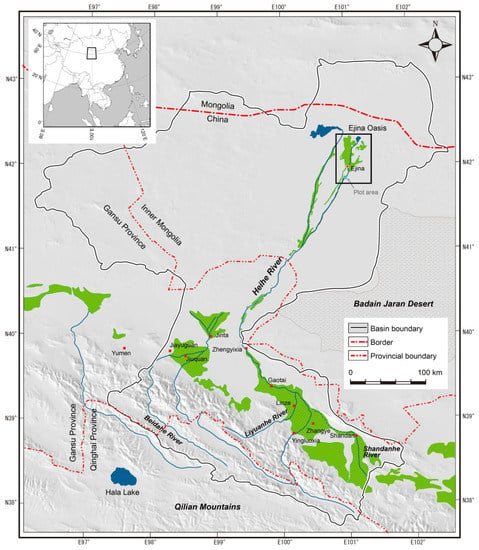
Figure 1.
Study area of the Heihe River basin and surrounding areas.
This research aims to evaluate the outcomes of an ecological restoration project, namely SCMPH, implemented in the lower reaches of the Heihe River basin. The study is conducted from both multi-temporal and multi-scale aspects, taking agriculture and afforestation activities into consideration to identify whether increases in vegetation coverage indicate ecological restoration in the locality. Specifically, this research: (1) analyzes the changes in vegetation coverage using multi-temporal remote sensing data together with a ground-based plot survey; and (2) investigates the perception of local residents on the changes in vegetation coverage using a questionnaire. Section 2 introduces the study area. Section 3 explains the three analytical methods used: remote sensing data analysis, plot survey, and questionnaire survey. Section 4 reports the analytical results. The concluding section discusses the perceptions of local residents and the impacts of SCMPH on vegetation changes in the study area.
2. The Study Area
As one of the largest inland river basins in China’s arid northwestern region, the Heihe River basin is located north of the Qilian Mountains and situated in the middle of the Hexi Corridor (Figure 1). The river is 821 km long, flowing through three provinces (or autonomous regions): Qinghai, Gansu, and the Inner Mongolia of China; its watershed covers an area of 128,283 km2 [19,20]. The river basin can be divided into upper, middle, and lower reaches based on ecological and socioeconomic features of the different areas. The upper reaches are mainly covered by mountains and glaciers and characterized by a cold and humid (or semiarid) climate. Runoff formation process in the entire Heihe River basin largely depends on the precipitation and meltwater of the upper reaches. The annual precipitation of the upper reaches ranges from 300 mm to 500 mm, and the annual mean air temperature was below 2 °C during 1960–2006 [21,22]. The middle reaches of the Heihe River have a typical alluvial fan shape [23]. The annual precipitation of the middle reaches ranges from 100 mm to 300 mm, and the annual potential evaporation is about 2500 mm [22]. The lower reaches of the Heihe River basin cover more than 114,000 km2, with over 90% of the land cover occupied by the Gobi Desert [19]. The lower reaches maintain a typical continental arid climate, with annual precipitation levels less than 100 mm and annual potential evaporation levels at or more than 3000 mm [24].
Ejina County is located in the terminal area of the Heihe River basin, in the west of Inner Mongolia (100°90′–101°42′ E, 41°85′–42°50′ N), with an area of 3288 km2. It is a typical oasis found in arid areas. The mean temperature in Ejina County is 9.5 °C, and the mean annual precipitation was 54.0 mm during 1973–2013 (Appendix Figure A1). The annual potential evaporation of this area ranges from 3700 to 4000 mm [19]. Under these arid conditions, surface water from the Heihe River is a crucial water source for the local ecosystem. The riverside areas of the oasis are dominated by the perennial phreatophytes including Populus euphratica, and Tamarix ramosissima Ledeb. The main vegetation species are shown in (Appendix Figure A2). In 2010, the five townships and one agricultural zone under the jurisdiction of Ejina County had a total population of approximately 16,200 living in 10,450 households [25]. People in Ejina County mainly depend on pastoral and farming activities for subsistence. Camels and goats are the principal livestock, while melon and cotton are the main crops in the region [8].
The lower reaches of Heihe River basin experienced a dramatic environmental change between the 1950s and the 1990s. The annual river discharge at the Zhengyixia hydrological station declined from 12.83 × 108 m3 in 1954 to 6.60 × 108 m3 in 2000 (Appendix Figure A3), and the groundwater level in the lower reaches declined from 0.5–1.0 m in the late 1940s to 3.0–4.0 m in the 1990s [26]. This is partially due to the expansion of farmland in both the middle reaches and lower reaches of the Heihe River basin (Appendix Figure A4). The decrease in river discharge and decline of groundwater level caused the two terminal lakes, the West Juyan lake with an area of 267 km2 and the East Juyan lake with an area of 35 km2, to dry up in 1964 and 1991, respectively [21]. This deterioration of the water environment resulted in a significant decrease of vegetation coverage throughout the oasis, which has contributed to severe sandstorms, consequently furthering wind erosion, soil impoverishment, and desertification [19,24].
3. Material and Methods
3.1. Remote Sensing Data Analysis
The Normalized Difference Vegetation Index (NDVI) derived from satellite sensor data with a high temporal resolution is widely used to investigate the dynamics of vegetation, especially in arid and semiarid areas [27,28,29]. NDVI can quantitatively evaluate vegetation growth: high coverage vegetation generates large positive values, soil and non-vegetated coverage generate slightly positive values, and water bodies generate negative values. Considering data availability and reliability, we acquired our NDVI data using images from Thematic Mapper (TM) and Enhanced Thematic Mapper Plus (ETM+) sensors on board Landsat-5 and Landsat-7 platforms, respectively, provided by the United States Geological Survey (USGS) (Appendix Table A1).
The images acquired from the USGS were calibrated using radiometric coefficients provided by [30]. Next, the atmospheric correction and mosaic of each scene was performed in order to weaken the interference from atmospheric differences in various scenes and to achieve full coverage of the region of interest. After pre-processing, NDVI and differences in NDVI were acquired from all pixels in the image using GRASS GIS 6.4 software. The NDVI of each pixel was calculated from the formula presented in Equation (1).
Vegetation cover grades were classified into four groups by adopting the widely used classification criteria from previous studies in the lower reaches (Table 1), where a different NDVI group represents a different grade of vegetation coverage [31,32].

Table 1.
Description of vegetation cover grades.
Images acquired in 2001–2004, 2007, and 2009–2012 were used for a time-series analysis of vegetation change in the Ejina Oasis (Figure 1, Appendix Table A1). In order to ensure the best observations and analyses of vegetation responses, we used images taken in August for this study. August is widely recognized as the month that has the densest vegetation in Ejina Oasis. Images acquired in August have been utilized in other studies on vegetation changes in Ejina Oasis [29,33].
Mosaic images created from five different scenes available in 2001 and 2012 were used to analyze vegetation change in the entire lower reaches before and after SCMPH. We estimated the difference in NDVI before and after the project implementation (dNDVI) using Equation (2).
We then classified the land cover into the following four types: significant decrease in NDVI for dNDVI values less than −0.05; no change or slight decrease in NDVI for dNDVI values between −0.05 and 0; no change or slight increase in NDVI for dNDVI values between 0 and 0.05; and significant increase in NDVI for dNDVI values greater than 0.05. Note that the ETM+ data observed in 2012 have data gaps with a stripe shape due to the failure of Scan Line Corrector, and, therefore, the data were only used for a rough understanding of vegetation change as well as pinpointing available NDVI to compare with local people’s perceptions on vegetation change, which will be explained in the Section 3.3.
3.2. Plot Survey
We conducted a plot survey to examine the changes of vegetation species in response to SCMPH. This method can be used to examine the detailed vegetation species growing in one fixed area (usually a 100 m2 plot). The study area of this survey (41°47.447–47.448′ N, 100°57.879–58.131′ E, 1410 m elevation) is located on the riverbank of the Heihe River, where the densest vegetation coverage and greatest variety of vegetation species in the lower reaches are observed (41–43° N, 100–102° E).
A rectangle plot was established, oriented from east to west, with a length of 350 m and a width of 20 m. The data for this survey were acquired from two surveys of the same plot conducted on 27 September 2003 and 13–19 September 2013. The methods were identical in both surveys. Measurements were taken of the following: diameters of all living trees at breast height (DBH) (for those taller than 200 cm) or at a height of 10 cm (for those less than 200 cm); the heights of the living parts and dead ends of the trees; and the branch spreads at north, south, east, and west directions. Furthermore, using the standard equation of ellipsoidal area, the crown projection area (CPA) was calculated as the ellipsoidal area from branch spreads at north, south, east, and west.
3.3. Semi-Structured Questionnaire Survey
In order to examine the local residents’ awareness of the project outcomes, a questionnaire was designed following methods used in previous studies [34,35,36,37,38,39]. The questionnaire targeted residents who have lived more than 10 years in the lower reaches and who were currently conducting farming and/or pastoral activities for a living. All respondents were selected randomly and interviewed independently in semi-structured interviews using questionnaires. The survey was carried out in three local communities in Dalaikubu town, Ejina County, in January 2014. The interviews were conducted in Chinese or Mongolian, according to the language preference of the interviewees, with the help of local interpreters.
The questionnaire was comprised of four sections: (1) background information of respondents, (2) perceived/predicted ecological change in the past decade and in the next decade if the efforts from SCMPH are terminated, (3) perceived changes of vegetation coverage in the past decade (increase, decrease, or no change), and (4) vegetation species used in their livelihoods. Although we asked the respondents to report their perceived environmental changes in Ejina as a whole, we assumed that their perceptions might be different depending on where their land is located. Therefore, all the respondents were also asked to indicate on a map where their pasture and/or farmland was located in the region. We classified locations of respondents’ land into two groups based on the vegetation type. One is a riparian area adjacent to the Heihe River. The other is the Gobi area, which lacks water most of the year, and where the vegetation is confined to a few varieties of grasses and herbs. The majority of our respondents have pastures located in the Gobi area, and only a few of them own pastures in a riparian area.
We performed 163 semi-structured interviews using questionnaires, which represents 1% of the population. Among the people we surveyed, 3 respondents had lived in the lower reaches for less than 10 years, and 13 respondents failed to indicate the locations of their pastures and/or farmland. These 16 responses were removed from the study making the actual sample size 147. We asked the respondents to subjectively evaluate their understanding of the contents of SCMPH, and 101 of 147 interviewees responded that they understood the contents of SCMPH fairly well, while 36 interviewees responded that they did not know much about SCMPH. Additionally, we investigated the relationship between actual vegetation changes shown by dNDVI for the pastures and/or farmland of the respondents and the changes in vegetation coverage that the respondents perceived. We classified all respondents into four groups according to the difference between the actual changes and the perceived changes (Table 2). The spatial relationships of the different groups were analyzed using GRASS GIS 6.4 software.

Table 2.
Confusion Matrix illustrating the relationships between the difference in Normalized Difference Vegetation Index (NDVI) before and after the project implementation (dNDVI) and perceived changes of local residents in vegetation coverage.
4. Results
4.1. Vegetation Changes in the Lower Reaches of the Heihe River Basin
We adopted two methods to examine actual vegetation changes in the study area. On one hand, the analysis of remote sensing data revealed a clear increasing trend in vegetation in the areas with medium and high vegetation coverage (Figure 2). From 2001 to 2011, NDVI was observed to increase in 775 km2 and decrease in 136 km2 of the entire lower reaches. Most of the areas where NDVI increased are distributed alongside the Heihe River. In the Ejina Oasis, NDVI was observed to increase in 203 km2 and decrease in 53 km2, which account for 15.1% and 4.1% of the total area of the Ejina Oasis, respectively. Among the four types of vegetation-covered areas classified by dNDVI, non-vegetation cover decreased from 66.4% (498.2 km2) in 2001 to 59.3% (362.8 km2) in 2011. At the same time, the proportion of medium vegetation cover increased from 7.0% (90.9 km2) in 2001 to 12.4% (160.3 km2) in 2011 for the same region. Sparse vegetation cover and high vegetation cover had little change from 2001 to 2011.
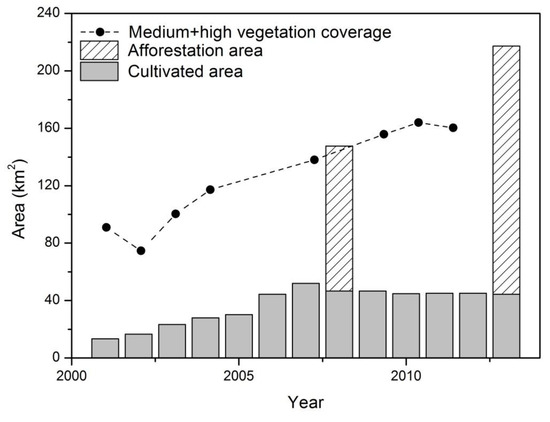
Figure 2.
Changes of medium and high vegetation coverage areas based on the remote sensing data analysis, statistical data of cultivated areas, and the afforestation areas in Ejina Country (statistical data of afforestation areas are only available for 2008 and 2013).
On the other hand, the plot survey also showed an increase of vegetation biomass (Figure 3). From 2003 to 2013, the crown projections indicate a slight increase of total vegetation coverage in the sample plot. The increase includes both predominant perennials, i.e., Populus eupharatica, Tamarix ramosissima, and Achnatherum splendens, and predominant annuals, i.e., Lycium ruthenicum, Ephedra przywalskii, Arnebia fimbriata, Limonium aureum, Reaumuria soongorica, and Peganum harmala (Appendix Figure A2). However, these plants were distributed only 0–300 m away from the river, and in locations of 300 m or further from the river, there were only Gobi plants such as Haloxylon ammodendron. Total vegetation coverage in the plot increased from 28.4% in 2003 to 31.5% in 2013, and the change is especially obvious 100–150 m away from the river. Moreover, three dominant vegetation species illustrated different changing patterns during the period: Achnatherum splendens experienced the greatest increase, Populus euphratica increased moderately, and Tamarix ramosissima changed only slightly.

Figure 3.
Comparison of crown projection diagrams and vegetation coverage of the sample plot. The above two figures show the crown projection diagrams in 2003 and 2013 in the sample plot (Populus euphratica in green color, Achnatherum splendens in yellow color and Tamarix ramosissima in orange color). The bottom figure shows the total vegetation coverage changes of Populus euphratica, Achnatherum splendens and Tamarix ramosissima in the sample plot between 2003 and 2013.
4.2. Residents’ Perceptions of Ecological Changes in the Lower Reaches of the Heihe River Basin
Among the 147 respondents of the semi-structured questionnaire, 75% were born in the lower reaches and 71% are conducting pastoral activities and/or farming as a main income source for living. The spatial distribution of the respondents’ pastures ranged from the west to the east of the lower reaches of the Heihe River basin.
Figure 4 shows the respondents’ perception of local ecological changes from 2003 to 2013 and their anticipation of local ecological changes from 2014 to 2024 if SCMPH is terminated. The survey data indicate that most of the respondents had a pessimistic outlook regarding the ecological conditions in the lower reaches for the next decade. This is despite the fact that many respondents answered that ecological conditions in the lower reaches had improved to some extent in the past decade.
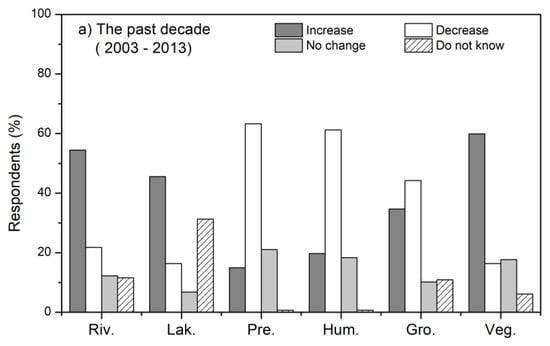
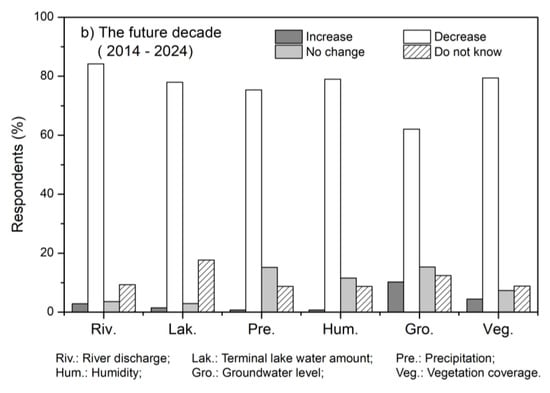
Figure 4.
Residents’ perceptions to local ecological change from (a) 2003 to 2013, and (b) anticipations to local ecological changes from 2014 to 2024 in Ejina Country if SCMPH is terminated.
Specifically, as shown in Figure 4, when respondents were asked about their perception of the ecological changes from 2003–2013, about half recognized increases in the discharge of the Heihe River (54.4%), terminal lake water amount (45.6%), and vegetation coverage area (59.9%). On the other hand, more than 60% of the respondents anticipated decreases in the river discharge (84.2%), terminal lake water amount (77.9%), and vegetation coverage (79.4%) if SCMPH were terminated in the future. This pessimistic view of the future emphasizes the uncertainty of the residents regarding the sustainability of the achievements resulting from the implementation of the SCMPH if the project is not continued.
The difference in the responses about precipitation, humidity, and groundwater level for the time periods of 2003–2013 and 2014–2024 were smaller (Figure 4). Fluctuations in precipitation, humidity, and groundwater levels tend to be less perceptible by the general public. Nonetheless, many respondents still considered these indicators would decrease further in the future. Many respondents recognized decreases in the precipitation (63.3%), humidity (61.2%), and groundwater level (44.2%), while a larger proportion of respondents expected further decreases in these three indicators, i.e., 75.4% in terms of precipitation, 79% in terms of humidity, and 62% in terms of groundwater level.
In order to investigate the relationship between responses of the local residents regarding water and vegetation changes from 2003 to 2013, we examined the responses of the 88 individuals who answered that their general impression of the vegetation in Ejina country was on the “increase” during 2003–2013. The local residents in this subset were more likely to respond that increases had occurred in all of the items related to vegetation and water. In particular, 70.5% of the respondents in this subset considered that the river water amount released to Ejina had increased while in comparison, 54.4% of respondents in the full dataset had this perception. Additionally, 54.5% of the subset maintained the perception that Juyan Lake’s water deposits had increased while in comparison, 45.6% of respondents in the full dataset maintained this view.
The distance of the respondents’ pasture/farmland from the center of Ejina appears to influence the results of the survey. Figure 5 shows a comparison of perceptions of local ecological changes between the respondents who own pastures and/or farmland in riparian areas and those who own pastures and/or farmland in Gobi areas. Respondents who have pastures and/or farmland in riparian areas are more likely to perceive an “increase” in vegetation changes from 2003 to 2013, while respondents who have pastures and/or farmland in Gobi areas are more likely to perceive a “decrease” or “no change” in vegetation changes from 2003 to 2013. In other words, local residents living in the riparian areas tend to recognize a positive impact of SCMPH, whereas those living in the Gobi areas may actually perceive a negative impact. Figure 6 shows a comparison between the actual changes in vegetation coverage measured by dNDVI and the changes perceived by the respondents at the same location. The red dots indicate the areas where nine respondents perceived an increase in vegetation coverage throughout the past decade despite a negative dNDVI. The blue dots indicate the areas where 16 respondents perceived a decrease in vegetation coverage despite a positive dNDVI.
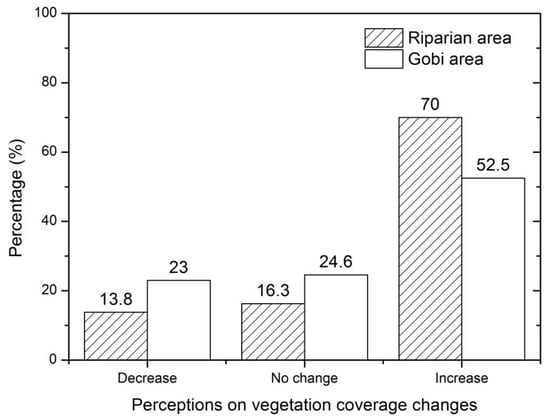
Figure 5.
Comparison between respondents who own grasslands in riparian areas and those who own grasslands in Gobi areas on their perceptions to vegetation coverage changes from 2003 to 2013.
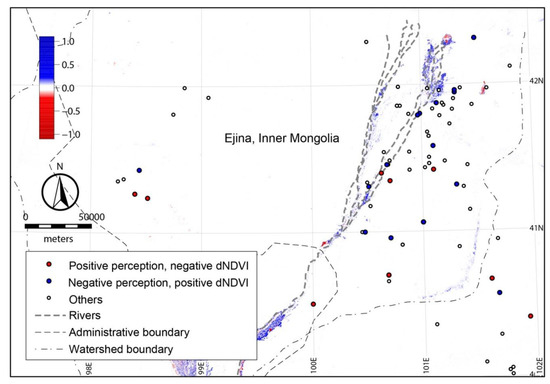
Figure 6.
NDVI changes (dNDVI) of the lower reaches between 2001 and 2012 and people’s perceptions on vegetation coverage changes.
5. Discussion and Conclusions
5.1. Vegetation Increase and Vegetation Restoration
Many previous studies on vegetation changes in the lower reaches of Heihe River basin have assumed that vegetation increase is a sign of vegetation recovery/restoration [12,19,29]. However, vegetation increase and vegetation recovery/restoration could be different processes. While vegetation increase simply refers to the enlargement of vegetation cover, vegetation recovery/restoration suggests a more comprehensive process in terms of both ‘quantity’ and ‘quality’, i.e., area enlargement as well as a gradual recovery of species structure/diversity.
In this study, we observed an increasing trend of medium and high vegetation cover and vegetation biomass; however, many other factors may affect the change of the vegetation cover, including the increase of cultivated lands and afforested areas. Figure 2 indicates that the increase of cultivated lands in the lower reaches from 2001 to 2011 may have contributed to the observed increase of medium and high vegetation cover. In Ejina county, the area of the cultivated land has increased more than three-fold, from 13.31 km2 in 2001 to 45.10 km2 in 2011 (Figure 2 and Figure A4). This is a considerable fraction (15.7%) of the total area of vegetation cover increase observed over the decade. The coefficient of determination between cultivated area and the areas with medium and high vegetation coverage is 0.838. Therefore, cultivation could be considered as a primary reason for the increase in the areas of medium and high vegetation coverage.
On the other hand, the field survey suggested that afforestation projects may also contribute to the increase of vegetation cover in the lower reaches. In Ejina, total afforestation area reached 101 km2 in 2008, accounting for more than 10% of the total forest area [9]. This area is equivalent to more than 70% of the total medium and high vegetation cover in 2001 in Ejina (Figure 2). In 2013, the afforestation area increased to 173 km2 [40].
In addition to the increase of cultivated lands and afforested areas, since there was little change in the annual mean temperature and annual precipitation during 2000–2013, the increase of river discharge due to SCMPH has certainly helped to increase the vegetation cover in riparian areas of the lower reaches of the Heihe River basin [11,23,41,42]. In the meantime, grazing bans initiated by SCMPH might have contributed to the increase of vegetation cover as well, as observed in the sample plot.
In summary, the vegetation recovery/restoration outcomes of SCMPH may not be as significant as many of the previous reports in the literature have indicated. Our conclusion is consistent with [29]. They concluded that the seasonal accumulated NDVI trend magnitudes higher than 0.14 a−1 are attributable to cultivated land reclamation and are, therefore, not natural vegetation rejuvenation or recovery. The dark blue colored areas with high dNDVI illustrated in Figure 6 are equivalent to the high NDVI trends in [29]. This suggests that those areas are probably expanding cultivated or afforested lands rather than actual vegetation recovery/restoration.
5.2. People’s Perceptions of the Environmental Changes
This study compared the perceptions of local residents on ecological conditions from various aspects. On one hand, according to the questionnaire survey, many respondents perceived improvements in the ecological conditions of the lower reaches during the past decade. On the other hand, the majority of the respondents were more pessimistic about the ecological conditions in the lower reaches for the next decade. Furthermore, our survey reveals that local residents living in the riparian areas had more recognition of the positive impacts of SCMPH, whereas those living in the Gobi areas had more negative perceptions of the impact of the projects.
The perception gap on vegetation changes between those who have pastures and/or farmland in riparian areas and those who have pastures and/or farmland in Gobi areas might in part be attributable to the effects of the concrete irrigation channels constructed as a part of SCMPH. During our survey, several respondents mentioned that concrete irrigation channels have redistributed the water resources within the Ejina Oasis in favor of (1) forest recovery in riparian areas; (2) recovery of terminal lake surface area; and (3) farmland irrigation. Consequently, the local residents whose pastures and/or farmland are closer to either the natural river course or water channels would have better access to water, while the local residents whose lands are located in distant Gobi areas would receive much less water resources. Meanwhile, respondents also reported that fences were built to prevent livestock, particularly goats, from approaching the riparian plants. Fences, together with the irrigation channels, hinder the movement of livestock and significantly decrease the degree of seasonal mobility.
In other words, the SCMPH has redistributed the water resources and affected livestock breeding in the Ejina Oasis. Our survey suggests a social divide or interest conflict between riparian areas and Gobi areas as an unexpected outcome of the implementation of an ecological restoration program. This finding of ours is consistent with [41] who argued that the implementation of SCMPH has led to an income disparity and social stratification between peoples in riparian and Gobi areas.
In conclusion, SCMPH has increased the vegetation coverage in the Ejina Oasis to a certain level, especially in the riparian areas, but this increase may not be the same as a recovery/restoration process of the vegetation in the region. In fact, large-scale afforestation projects may result in the degradation of vegetation in the surrounding areas despite the increase of vegetation cover in the targeted afforested areas. For example, plant transpiration and evaporation from the soil surface in afforested areas can decrease the soil moisture and deplete the groundwater, which may cause vegetation degradation over the long term [43]. Yang et al. [44] also argued that the creation of artificial ecosystems is ill-suited for combating desertification. Finally, while our research has aimed to help define the problem in order to foster comprehensive management and inclusive decision-making processes of ecological restoration projects, further research is necessary to clarify social aspects of such projects. Specifically, more studies are needed concerning who is adversely affected the most in Gobi areas, how they are affected, and how they are coping with the difficulties.
Author Contributions
Conceptualization, T.Z., T.A., and M.H.; Methodology, T.Z., T.A., J.L. and K.Y.; Software, T.Z. and T.A.; Validation, T.Z., T.A., M.H. and J.L.; Formal Analysis, T.Z., T.A., S.K. and J.L.; Investigation, T.Z., T.A., J.L., A.K., S.K.; Resources, T.A. and K.Y.; Data Curation, T.Z.; Writing-Original Draft Preparation, T.Z.; Writing-Review & Editing, T.A., A.K., S.K. and J.L.; Visualization, T.Z.; Supervision, T.A. and M.H.; Project Administration, T.Z.; Funding Acquisition, T.A.
Acknowledgments
The authors would like to express their deepest gratitude to the Research Institute for Humanity and Nature (RIHN) in Japan, who conducted the field observation survey in 2003 and provided the field observation data for analysis; Yuan Qi and his students from Cold and Arid Regions Environmental and Engineering Research Institute, Chinese Academy of Science, and Xiaogang Li from Okayama University for their support on the vegetation field survey; and all the people in Ejina County who have kindly cooperated with the questionnaire during the fieldwork. This work was supported by the JSPS KAKENHI Grant Numbers 17K12855 and 25740064 as well as the Sumitomo Foundation, Heiwa Nakajima Foundation, Asahi Group Foundation and the Ministry of Education, Culture, Sports, Science and Technology (MEXT) of Japan through the Grant-in-Aid Program for Leading Graduate Schools “Graduate Program in Sustainability Science—Global Leadership Initiative (GPSS-GLI)” of The University of Tokyo.
Conflicts of Interest
The authors declare no conflicts of interest.
Appendix A

Figure A1.
Annual mean temperature and annual precipitation in Ejina Country from 1973 to 2013. (Data source: National Oceanic and Atmospheric Administration, USA)
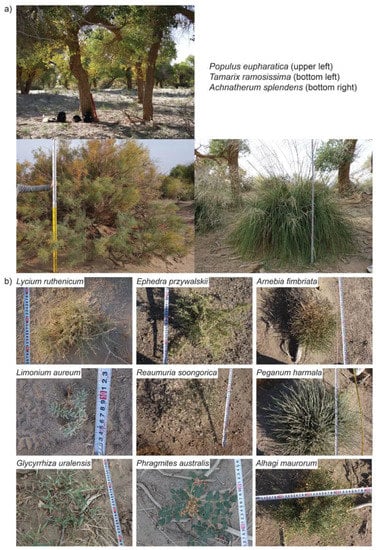
Figure A2.
Vegetation species in the lower reaches of the Heihe River basin. (a) Predominant perennials; (b) Predominant annuals
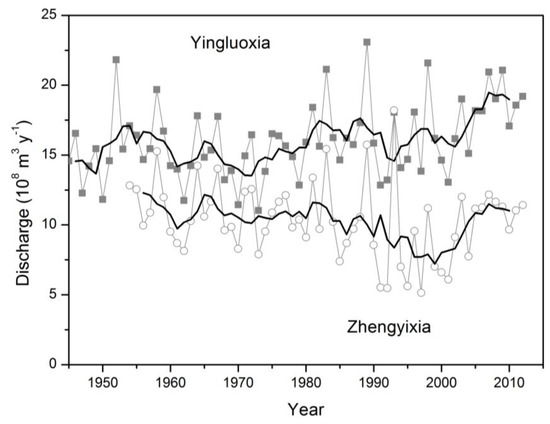
Figure A3.
Annual river discharge at Yingluoxia hydrological station (gray box) and Zhengyixia hydrological station (white circle). The gray line connects the annual river discharge continuously and the black lines represent five-year average of the river discharge
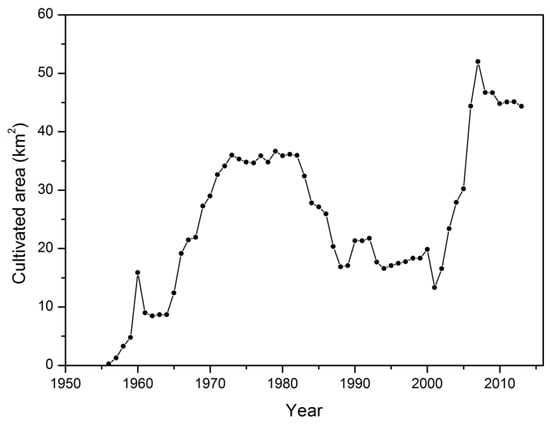
Figure A4.
Changes of cultivated area in Ejina from 1954 to 2013. (Data source: Bureau of Agriculture, Ejina County)

Table A1.
Landsat data used in this study.
Table A1.
Landsat data used in this study.
| Lower Reaches Region | Ejina Oasis | ||||
|---|---|---|---|---|---|
| Path/Row | Acquisition Date | Sensor | Path/Row | ACQUISITION DATE | Sensor |
| 133/31 | 21 August 2001 | TM | 133/31 | 06 August 2007 | TM |
| 134/31 | 20 August 2001 | ETM+ | 133/31 | 11 August 2009 | TM |
| 135/31 | 19 August 2001 | TM | 134/31 | 12 August 2001 | TM |
| 133/32 | 21 August 2001 | TM | 134/31 | 15 August 2002 | TM |
| 134/32 | 20 August 2001 | ETM+ | 134/31 | 02 August 2003 | TM |
| 133/31 | 27 August 2012 | ETM+ | 134/31 | 20 August 2004 | TM |
| 134/31 | 18 August 2012 | ETM+ | 134/31 | 21 August 2010 | TM |
| 135/31 | 25 August 2012 | ETM+ | 134/31 | 08 August 2011 | TM |
| 133/32 | 27 August 2012 | ETM+ | |||
| 134/32 | 18 August 2012 | ETM+ | |||
References
- UNCCD. United Nations Convention to Combat Desertification in Countries Experiencing Serious Drought and/or Desertification, Particularly in Africa; A/AC.241/27; United Nations: Paris, France, 1994. [Google Scholar]
- UNCCD. Land and Soil in the Context of a Green Economy for Sustainable Development, Food Security, and Poverty Eradication: The Submission of the UNCCD Secretariat to the Preparatory Process for the Rio+20 Conference; UNCCD: Bonn, Germany, 2011. [Google Scholar]
- Lu, Q.; Wu, B. Disaster assessment and economic loss budget of desertification in China. Popul. Resour. Environ. China 2002, 12, 29–33. (In Chinese) [Google Scholar]
- He, Z.; Zhao, W. Characterizing the spatial structures of riparian plant communities in the lower reaches of the Heihe River in China using geostatistical techniques. Ecol. Res. 2006, 21, 551–559. [Google Scholar] [CrossRef]
- Wen, X.; Wu, Y.; Su, J.; Zhang, Y.; Liu, F. Hydrochemical characteristics and salinity of groundwater in the Ejina Basin, Northwestern China. Environ. Geol. 2005, 48, 665–675. [Google Scholar] [CrossRef]
- Guo, Q.; Feng, Q.; Li, J. Environmental changes after ecological water conveyance in the lower reaches of Heihe River, northwest china. Environ. Geol. 2009, 58, 1387–1396. [Google Scholar] [CrossRef]
- Ministry of Water Resources. Short-Term and Comprehensive Management Plan of Heihe River Basin; Ministry of Water Resources: Addis Ababa, Ethiopia, 2002.
- Wang, Y.; Feng, Q.; Chen, L.; Yu, T. Significance and effect of ecological rehabilitation project in inland river basins in Northwest China. Environ. Manag. 2013, 52, 209–220. [Google Scholar] [CrossRef] [PubMed]
- Zhong, J. Establishing green ecological barrier in Northwestern China Achievement of 30 years’ afforestation efforts in Ejina. J. Inn. Mong. For. 2008, 11, 12–13. (In Chinese) [Google Scholar]
- Wang, P.; Zhang, Y.; Yu, J.; Fu, G.; Ao, F. Vegetation dynamics induced by groundwater fluctuations in the lower Heihe River Basin, northwestern China. J. Plant Ecol. 2011, 4, 77–90. [Google Scholar] [CrossRef]
- Wang, P.; Yu, J.; Zhang, Y.; Fu, G.; Min, L.; Ao, F. Impacts of environmental flow controls on the water table and groundwater chemistry in the Ejina Delta, northwestern China. Environ. Earth Sci. 2011, 64, 15–24. [Google Scholar] [CrossRef]
- Si, J.; Feng, Q.; Zhang, X.; Su, Y.; Zhang, Y. Vegetation changes in the lower reaches of the Heihe River after its water import. Acta Bot. Boreal.-Occident. Sin. 2005, 25, 631–640. (In Chinese) [Google Scholar]
- Guo, Q.; Yang, Y.; Chen, Z. Remote sensing monitoring vegetation cover change in Ejina County after Heihe river water was distributed. J. Water Resour. Water Eng. 2010, 21, 65–71. (In Chinese) [Google Scholar]
- Cao, S.; Xu, C.; Chen, L.; Wang, X. Attitudes of farmers in China’s northern Shaanxi Province towards the land-use changes required under the Grain for Green Project, and implications for the project’s success. Land Use Policy 2009, 26, 1182–1194. [Google Scholar] [CrossRef]
- Karanth, K.K.; Nepal, S.K. Local residents perception of benefits and losses from protected areas in India and Nepal. Environ. Manag. 2012, 49, 372–386. [Google Scholar] [CrossRef] [PubMed]
- Maikhuri, R.K.; Nautiyal, S.; Rao, K.S.; Saxena, K.G. Conservation policy-people conflicts: A case study from Nanda Devi Biosphere Reserve (a World Heritage Site), India. For. Policy Econ. 2001, 2, 355–365. [Google Scholar] [CrossRef]
- Akiyama, T.; Li, J.; Kubota, J.; Konagaya, Y.; Watanabe, M. Perspectives on Sustainability Assessment: An Integral Approach to Historical Changes in Social Systems and Water Environment in the Ili River Basin of Central Eurasia, 1900–2008. World Future 2012, 68, 595–627. [Google Scholar] [CrossRef]
- Wang, Y.; Feng, Q. Study on the sustainability of ecological water transfer and rehabilitation project based on participant investigation. In Proceedings of the 2nd International Conference on Remote sensing, Environment and Transportation Engineering (RSETE), Nanjing, China, 1–3 June 2012; pp. 1–6. [Google Scholar]
- Jin, X.; Schaepman, M.; Clevers, J.; Su, Z.; Hu, G. Correlation between annual runoff in the Heihe River to the vegetation cover in the Ejina Oasis (China). Arid Land Res. Manag. 2010, 24, 31–41. [Google Scholar] [CrossRef]
- Wu, J. The effect of ecological management in the upper reaches of Heihe River. Acta Ecol. Sin. 2011, 31, 1–7. [Google Scholar] [CrossRef]
- Wang, G.; Cheng, G. Water resource development and its influence on the environment in arid areas of China—The case of the Hei River basin. J. Arid Environ. 1999, 43, 121–131. [Google Scholar]
- Kang, E. Hydrological Studies of the Heihe River Basin in the Northwest Arid Regions of China. Project Report on an Oasis-Region; Research Institute for Humanity and Nature: Kyoto, Japan, 2002. [Google Scholar]
- Akiyama, T. A Study on Groundwater Recharge System and Water Use in the Heihe River Basin in an Arid Region of China. Ph.D. Thesis, University of Tokyo, Tokyo, Japan, 2007. [Google Scholar]
- Feng, Q.; Cheng, G.D.; Endo, K.N. Towards sustainable development of the environmentally degraded River Heihe basin, China. Hydrol. Sci. J. 2001, 46, 647–658. [Google Scholar] [CrossRef]
- Bureau of Statistics. The 6th National Census of Population, Ejina Country; Ejina Country; National Bureau of Statistics: Beijing, China, 2012. (In Chinese) [Google Scholar]
- Si, J.; Feng, Q.; Xi, H.; Chang, Z.; Su, Y. Ejina Desert Oasis: A Fragile “Ecological Screen” in Inland Region of Northwest China. In Proceedings of the 2nd International Conference on Bioinformatics and Biomedical Engineering (ICBBE), Shanghai, China, 16–18 May 2008. [Google Scholar]
- Fabricante, I.; Oesterheld, M.; Paruelo, J.M. Annual and seasonal variation of NDVI explained by current and previous precipitation across Northern Patagonia. J. Arid Environ. 2009, 73, 745–753. [Google Scholar] [CrossRef]
- McGwire, K.; Minor, T.; Fenstermaker, L. Hyperspectral mixture modeling for quantifying sparse vegetation cover in arid environments. Remote Sens. Environ. 2000, 72, 360–374. [Google Scholar] [CrossRef]
- Zhang, Y.C.; Yu, J.J.; Wang, P.; Fu, G.B. Vegetation responses to integrated water management in the Ejina basin, northwest China. Hydrol. Process. 2011, 25, 3448–3461. [Google Scholar] [CrossRef]
- Chander, G.; Markham, B.L.; Helder, D.L. Summary of current radiometric calibration coefficients for Landsat MSS, TM, ETM+, and EO-1 ALI sensors. Remote Sens. Environ. 2009, 113, 893–903. [Google Scholar] [CrossRef]
- Chang, Y.; Bao, D.; Bao, Y. Satellite monitoring of the environment recovery effect in the Heihe River downstream region for the last 11 years. Proced. Environ. Sci. 2011, 10, 2385–2392. [Google Scholar] [CrossRef]
- Guoqian, W.; Xuequan, W.; Bo, W.; Qi, L. Desertification and Its Mitigation Strategy in China. J. Resour. Ecol. 2012, 3, 97–104. [Google Scholar] [CrossRef]
- Jin, X.M.; Schaepman, M.E.; Clevers, J.G.P.W.; Su, Z.B.; Hu, G.C. Groundwater depth and vegetation in the Ejina area, China. Arid Land Res. Manag. 2011, 25, 194–199. [Google Scholar] [CrossRef]
- Klintenberg, P.; Seely, M.; Christiansson, C. Local and national perceptions of environmental change in central Northern Namibia: Do they correspond? J. Arid Environ. 2007, 69, 506–525. [Google Scholar] [CrossRef]
- Lee, H.F.; Zhang, D.D. Perceiving desertification from the lay perspective in northern China. Land Degrad. Dev. 2004, 15, 529–542. [Google Scholar] [CrossRef]
- Lee, H.F.; Zhang, D.D. Perceiving land-degrading activities from the lay perspective in northern China. Environ. Manag. 2005, 36, 711–725. [Google Scholar] [CrossRef] [PubMed]
- Lee, H.F.; Zhang, D.D. Perceiving the environment from the lay perspective in desertified areas, northern China. Environ. Manag. 2008, 41, 168–182. [Google Scholar] [CrossRef] [PubMed]
- Ward, D.; Ngairorue, B.T.; Apollus, A.; Tjiveze, H. Perceptions and realities of land degradation in arid Otjimbingwe, Namibia. J. Arid Environ. 2000, 45, 337–356. [Google Scholar] [CrossRef]
- Wezel, A.; Haigis, J. Farmer’s perception of vegetation changes in semi-arid niger. Land Degrad. Dev. 2000, 11, 523–534. [Google Scholar] [CrossRef]
- Bureau of Forestry. Current Development Condition of Foresty Industry in Ejina; Ejina Country; Bureau of Forestry: Ejina, China, 2014. (In Chinese) [Google Scholar]
- Wang, Y.; Feng, Q.; Si, J.; Su, Y.; Chang, Z.; Xi, H. The changes of vegetation cover in Ejina Oasis based on water resources redistribution in Heihe River. Environ. Earth Sci. 2011, 64, 1965–1973. [Google Scholar] [CrossRef]
- Akiyama Sakai, A.; Yamazaki, Y.; Wang, G.; Fujita, K.; Nakawo, M.; Kubota, J.; Konagaya, Y.T. Surfacewater-groundwater interaction in the Heihe River basin, Northwestern China. Bull. Glaciol. Res. 2007, 24, 87–94. [Google Scholar]
- Cao, S. Why large-scale afforestation efforts in China have failed to solve the desertification problem. Environ. Sci. Technol. 2008, 42, 1826–1831. [Google Scholar] [CrossRef] [PubMed]
- Yang, H.; Lu, Q.; Wu, B.; Yang, H.; Zhang, J.; Lin, Y. Vegetation diversity and its application in sandy desert revegetation on Tibetan Plateau. J. Arid Environ. 2006, 65, 619–631. [Google Scholar] [CrossRef]
© 2018 by the authors. Licensee MDPI, Basel, Switzerland. This article is an open access article distributed under the terms and conditions of the Creative Commons Attribution (CC BY) license (http://creativecommons.org/licenses/by/4.0/).